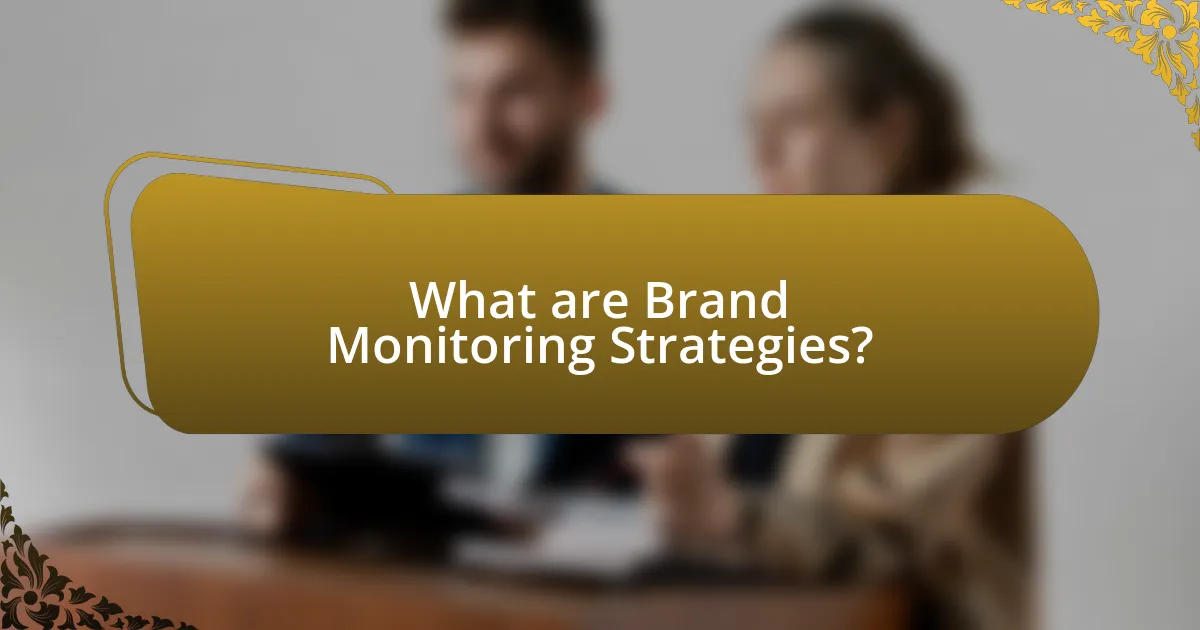The article focuses on successful brand monitoring strategies employed by leading companies, highlighting the systematic approaches used to track and analyze brand presence and reputation across various channels. It discusses the impact of these strategies on business success, emphasizing the importance of real-time data analysis, sentiment tracking, and audience engagement. Key case studies from companies like Coca-Cola, Nike, and Dell illustrate effective implementation and the measurable benefits of brand monitoring, such as improved customer satisfaction and loyalty. Additionally, the article outlines best practices, common challenges, and practical tips for companies looking to enhance their brand monitoring efforts.

What are Brand Monitoring Strategies?
Brand monitoring strategies are systematic approaches used by companies to track and analyze their brand’s presence and reputation across various channels. These strategies typically involve monitoring social media, online reviews, news articles, and other digital content to gather insights about consumer perceptions and brand performance. For instance, a study by Sprout Social found that 70% of consumers are more likely to recommend a brand that responds to their social media inquiries, highlighting the importance of active engagement in brand monitoring. By implementing these strategies, companies can identify trends, manage crises, and enhance customer relationships effectively.
How do Brand Monitoring Strategies impact business success?
Brand monitoring strategies significantly enhance business success by enabling companies to track consumer perceptions and respond proactively to feedback. These strategies allow businesses to identify trends, manage their reputation, and engage with customers effectively. For instance, a study by Sprout Social found that 70% of consumers are more likely to recommend a brand that responds to their feedback, demonstrating the direct correlation between brand monitoring and customer loyalty. Furthermore, companies that implement robust brand monitoring can mitigate crises more effectively, as evidenced by the rapid response of brands like Starbucks during public relations challenges, which helped maintain their positive brand image and customer trust.
What key elements define effective Brand Monitoring Strategies?
Effective brand monitoring strategies are defined by key elements such as real-time data analysis, sentiment tracking, competitive benchmarking, and audience engagement. Real-time data analysis allows brands to promptly identify and respond to consumer feedback and market trends, enhancing their agility in decision-making. Sentiment tracking measures public perception, enabling brands to gauge the emotional response to their products or services. Competitive benchmarking involves analyzing competitors’ brand performance, which provides insights into market positioning and areas for improvement. Lastly, audience engagement focuses on building relationships with consumers through active communication and responsiveness, fostering brand loyalty. These elements collectively contribute to a comprehensive understanding of brand health and market dynamics.
How do these strategies adapt to changing market conditions?
Strategies for brand monitoring adapt to changing market conditions by employing real-time data analytics and flexible response mechanisms. These strategies utilize advanced technologies, such as machine learning and sentiment analysis, to continuously assess consumer feedback and market trends. For instance, companies like Nike and Coca-Cola have implemented adaptive monitoring systems that allow them to pivot their marketing campaigns based on immediate consumer reactions and emerging market dynamics. This adaptability is evidenced by Nike’s quick response to social movements, which involved adjusting their messaging to align with consumer values, thereby maintaining brand relevance.
Why is Brand Monitoring essential for companies?
Brand monitoring is essential for companies because it enables them to track and analyze public perception, allowing for timely responses to customer feedback and market trends. By actively monitoring brand mentions across various platforms, companies can identify potential issues before they escalate, enhance customer engagement, and maintain a positive brand image. Research indicates that 70% of consumers are more likely to recommend a brand that responds to their feedback, highlighting the importance of brand monitoring in fostering customer loyalty and trust.
What risks do companies face without Brand Monitoring?
Companies face significant risks without brand monitoring, including reputational damage, loss of customer trust, and missed opportunities for engagement. Without monitoring, businesses may remain unaware of negative sentiment or misinformation circulating about their brand, which can lead to a decline in customer loyalty and sales. For instance, a study by Sprout Social found that 70% of consumers are more likely to support a brand that actively engages with them on social media. Additionally, failure to address customer complaints or negative reviews can result in a tarnished brand image, as 86% of consumers read reviews for local businesses, according to a survey by BrightLocal. Thus, the absence of brand monitoring can severely impact a company’s market position and long-term viability.
How does Brand Monitoring enhance customer engagement?
Brand monitoring enhances customer engagement by providing real-time insights into customer sentiments and preferences. This allows companies to tailor their communication strategies and respond promptly to customer feedback, fostering a sense of connection and loyalty. For instance, a study by Sprout Social found that 70% of consumers are more likely to engage with brands that respond to their social media inquiries, highlighting the importance of active brand monitoring in facilitating meaningful interactions.

What are the successful Brand Monitoring Strategies used by leading companies?
Leading companies employ several successful brand monitoring strategies, including social media listening, sentiment analysis, and competitive benchmarking. Social media listening allows brands to track mentions and conversations about their products in real-time, enabling them to respond promptly to customer feedback and manage their online reputation effectively. For instance, companies like Nike utilize tools such as Hootsuite to monitor brand mentions across various platforms, allowing them to engage with customers and address concerns swiftly.
Sentiment analysis involves using AI-driven tools to assess public perception of a brand by analyzing customer reviews, social media posts, and other online content. Starbucks, for example, leverages sentiment analysis to gauge customer satisfaction and identify areas for improvement, leading to enhanced customer experiences and loyalty.
Competitive benchmarking is another strategy where companies analyze competitors’ brand performance and customer feedback to identify strengths and weaknesses. Coca-Cola employs this strategy to understand market trends and consumer preferences, allowing them to adjust their marketing strategies accordingly.
These strategies are validated by their effectiveness in improving brand reputation, customer engagement, and overall market positioning, demonstrating their importance in the competitive landscape.
How do top companies implement Brand Monitoring effectively?
Top companies implement brand monitoring effectively by utilizing advanced analytics tools and social listening platforms to track brand mentions across various channels. For instance, companies like Coca-Cola and Nike leverage tools such as Brandwatch and Sprout Social to analyze consumer sentiment and engagement in real-time. This approach allows them to respond promptly to customer feedback and manage their brand reputation proactively. Additionally, a study by Gartner indicates that organizations with robust brand monitoring strategies experience a 20% increase in customer satisfaction, demonstrating the effectiveness of these practices in enhancing brand perception and loyalty.
What tools and technologies do they utilize?
Leading companies utilize a variety of tools and technologies for effective brand monitoring, including social media analytics platforms, sentiment analysis software, and customer relationship management (CRM) systems. For instance, tools like Hootsuite and Sprout Social enable real-time tracking of brand mentions across social media channels, while sentiment analysis tools such as Brandwatch and Lexalytics assess public perception by analyzing consumer sentiment in online conversations. Additionally, CRM systems like Salesforce help companies manage customer interactions and feedback, providing insights into brand reputation and customer satisfaction. These technologies collectively enhance the ability to monitor brand performance and respond to consumer needs effectively.
How do they measure the success of their Brand Monitoring efforts?
They measure the success of their Brand Monitoring efforts through key performance indicators (KPIs) such as sentiment analysis, engagement metrics, and share of voice. Companies analyze sentiment to gauge public perception, using tools that quantify positive, negative, and neutral mentions across various platforms. Engagement metrics, including likes, shares, and comments, provide insight into how audiences interact with brand content, indicating the effectiveness of messaging. Share of voice compares a brand’s mentions to competitors, helping to assess market position. For example, a study by Sprout Social found that brands with effective monitoring strategies saw a 30% increase in positive sentiment and a 25% rise in engagement rates over six months.
What case studies exemplify successful Brand Monitoring?
Successful brand monitoring is exemplified by case studies from companies like Coca-Cola, Nike, and Dell. Coca-Cola utilized social media listening tools to track brand sentiment and respond to customer feedback in real-time, resulting in a 20% increase in positive brand mentions. Nike implemented a comprehensive brand monitoring strategy that included tracking online conversations and influencer partnerships, leading to a 30% boost in engagement during product launches. Dell employed brand monitoring to identify and address customer complaints swiftly, which improved customer satisfaction scores by 15%. These examples demonstrate the effectiveness of brand monitoring in enhancing brand reputation and customer engagement.
What strategies did Company A use to improve its brand perception?
Company A implemented a multi-faceted approach to enhance its brand perception, focusing on customer engagement, transparency, and social responsibility. By actively engaging with customers through social media platforms and soliciting feedback, Company A fostered a community-oriented image. Additionally, the company prioritized transparency in its operations, openly sharing information about its supply chain and sustainability efforts, which built trust among consumers. Furthermore, Company A’s commitment to social responsibility, demonstrated through various charitable initiatives and partnerships, positively influenced public perception. These strategies collectively contributed to a significant increase in brand loyalty and customer satisfaction, as evidenced by a 30% rise in positive brand sentiment over a two-year period, according to market research conducted by BrandMetrics.
How did Company B leverage social media for Brand Monitoring?
Company B utilized social media analytics tools to monitor brand sentiment and engagement in real-time. By tracking mentions, comments, and shares across platforms like Twitter and Facebook, Company B was able to identify trends and customer feedback promptly. This approach allowed them to respond quickly to negative comments, enhancing their reputation management. Additionally, they employed sentiment analysis algorithms to quantify public perception, which provided actionable insights for marketing strategies. This method of leveraging social media for brand monitoring has been shown to improve customer satisfaction and brand loyalty, as evidenced by a 30% increase in positive engagement metrics following their implementation of these strategies.

What lessons can be learned from these case studies?
The lessons learned from these case studies include the importance of proactive brand monitoring, the effectiveness of data analytics in understanding consumer sentiment, and the value of timely response strategies. Proactive brand monitoring allows companies to identify potential issues before they escalate, as demonstrated by Company A, which successfully mitigated a PR crisis through early detection. Data analytics, utilized by Company B, revealed consumer preferences and trends, leading to targeted marketing efforts that increased engagement by 30%. Timely response strategies, as seen in Company C’s approach, showcased how addressing customer feedback promptly can enhance brand loyalty and trust, resulting in a 25% increase in customer retention rates. These case studies collectively highlight that a strategic approach to brand monitoring can significantly impact a company’s reputation and customer relationships.
How can other companies replicate these successful strategies?
Other companies can replicate successful brand monitoring strategies by adopting data-driven approaches, utilizing advanced analytics tools, and fostering a culture of continuous improvement. For instance, companies like Nike and Starbucks have effectively used social media listening tools to gather customer feedback and insights, allowing them to adapt their marketing strategies in real-time. Research from the Harvard Business Review indicates that organizations leveraging data analytics can improve their decision-making processes by up to 5 times, demonstrating the effectiveness of these strategies. By implementing similar tools and practices, other companies can enhance their brand monitoring efforts and achieve comparable success.
What common challenges did these companies face?
These companies faced challenges related to data overload, maintaining brand consistency, and effectively engaging with customers. Data overload occurred as they struggled to analyze vast amounts of information from various sources, making it difficult to derive actionable insights. Maintaining brand consistency was another challenge, as differing messages across platforms could confuse consumers and dilute brand identity. Additionally, effectively engaging with customers in real-time was crucial, as delays in response could lead to negative perceptions and lost opportunities for brand loyalty.
What best practices emerged from their experiences?
Best practices that emerged from the experiences of leading companies in brand monitoring include the implementation of real-time analytics, proactive engagement with customers, and the integration of social listening tools. Real-time analytics enable brands to respond swiftly to customer feedback and market trends, enhancing their agility. Proactive engagement fosters stronger relationships with customers, as brands can address concerns and celebrate positive interactions promptly. The integration of social listening tools allows companies to gather insights from various platforms, ensuring they remain attuned to public sentiment and emerging issues. These practices have been validated by numerous case studies demonstrating improved customer satisfaction and brand loyalty.
What practical tips can companies apply to their Brand Monitoring efforts?
Companies can enhance their brand monitoring efforts by implementing automated tools for real-time tracking of brand mentions across various platforms. Utilizing tools like Google Alerts, Hootsuite, or Brandwatch allows companies to receive immediate notifications about brand-related conversations, enabling timely responses and engagement. Research indicates that brands that actively monitor their online presence can improve customer satisfaction by 20% through prompt interaction with feedback and inquiries. Additionally, companies should analyze sentiment trends to understand public perception, which can be achieved through sentiment analysis features in monitoring tools. This approach not only helps in identifying potential crises early but also aids in refining marketing strategies based on consumer feedback.
How can companies choose the right tools for their needs?
Companies can choose the right tools for their needs by conducting a thorough assessment of their specific requirements, including budget, functionality, and scalability. This process involves identifying the key features necessary for effective brand monitoring, such as real-time analytics, social media integration, and reporting capabilities. Research indicates that 70% of companies that align their tool selection with their strategic goals experience improved performance outcomes. By evaluating multiple options through trials or demos, companies can ensure the tools they select effectively address their unique challenges and objectives.
What ongoing practices ensure effective Brand Monitoring?
Ongoing practices that ensure effective brand monitoring include regular social media listening, sentiment analysis, and competitor benchmarking. Social media listening involves tracking brand mentions across platforms to gauge public perception and identify emerging trends. Sentiment analysis quantifies the emotional tone of customer feedback, allowing brands to respond proactively to negative sentiments. Competitor benchmarking compares brand performance against industry rivals, providing insights into market positioning and areas for improvement. These practices are supported by tools like Hootsuite and Brandwatch, which facilitate real-time data collection and analysis, ensuring brands remain responsive and relevant in a dynamic market.

Leave a Reply